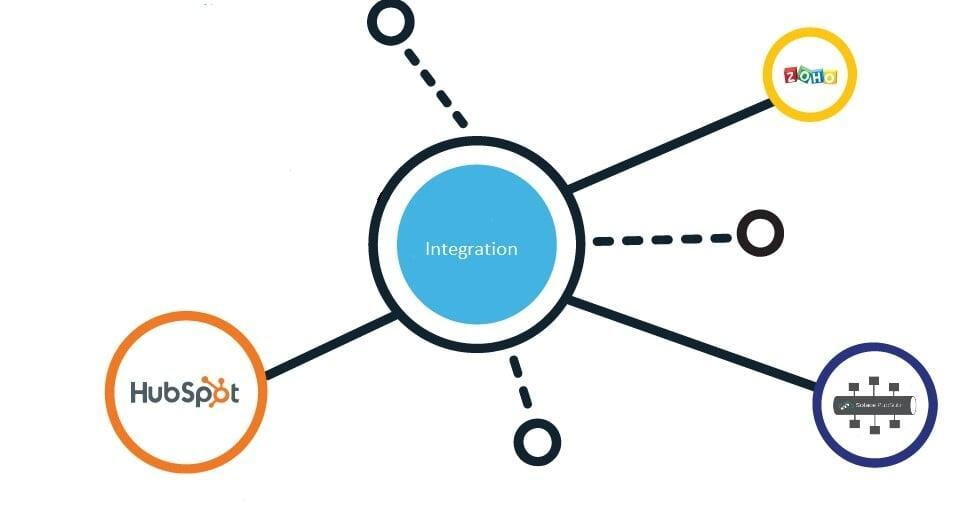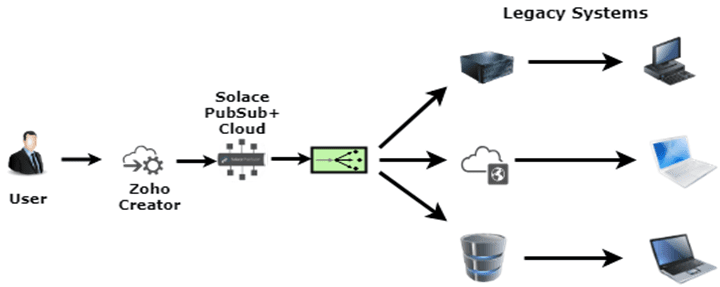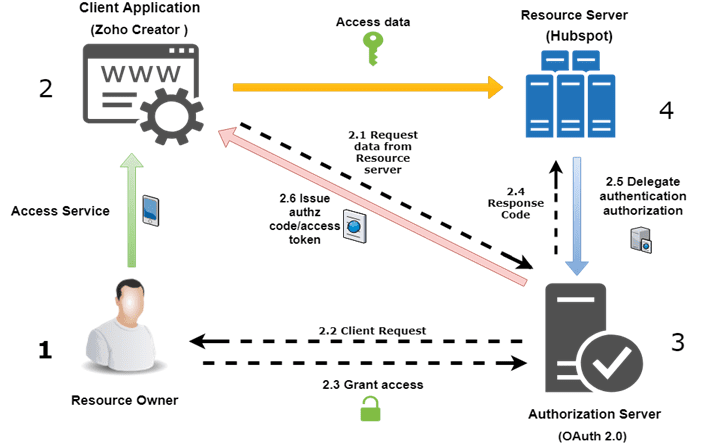
Integration is connecting two or more applications together so that the data can be moved from one app to another seamlessly.
Introduction
Zoho Creator can be integrated with third party applications using different methods viz REST over HTTP, OAUTH, Webhooks, etc.,
In this blog, you can get a brief idea about REST and OAUTH with their specific use cases.
REST API
REST API is an application programming interface (API) that uses HTTP requests to GET, PUT, POST and DELETE data.
Following link of Zoho provides the usage/configuration for REST API at Zoho Creator.
https://www.zoho.com/creator/help/api/rest-api/zoho-creator-rest-api.html
Zoho Creator and Solace Integration using REST
In this sample, you get an idea of integrating a micro service developed in Zoho Creator with Solace Cloud (Messaging As A Service via Solace PubSub+) .This in turn allows any legacy systems to be integrated with Zoho where Solace acts as a middleware backbone.

The above flow diagram shows the flow of data from Zoho Creator via a queue in Solace message broker to the Consumer systems (legacy or standard consumers/REST consumers).
For more information on how to configure/sign up to Solace PubSub+, please refer the below link.
https://solace.com/cloud/
For this use case, a Form is created in the micro services application with relevant fields in Zoho Creator.The required parameters for REST connectivity to Solace is done and the message is POSTED over REST to the Solace queue.
Upon submitting the form, the messages are delivered to the queue where a downstream application can consume successfully.
The idea of this use case is to have a cloud based micro service developed in Zoho Creator, to integrate with another cloud-based service Solace messaging.
This also enhances the integration of any legacy applications connecting to Solace which needs an integration with a micro service developed in Zoho Creator or any other technologies.
OAuth 2.0OAuth 2.0 focuses on client developer simplicity while providing specific authorization flows for web applications, desktop applications, mobile phones, and living room devices.
Refer the following link on OAUTH configuration related details in Zoho.
https://www.zoho.com/accounts/protocol/oauth.html
OAuth 2.0 Flow
The flow consists of four roles
- Resource Owner => User
- Client Application => Zoho Creator
- Authorization Server => OAuth 2.0
- Resource Server => Hubspot

The Resource Owner accesses the service via the client application. The client application requests for authorization of certain data present in database to the Resource server. This request goes to the Authorization Server.
The Authorization server forwarded this request to the user where the user approves/accepts the request. The User provides a Grant Access to the Authorization server. This grant access is sent as response code to the Resource Server. The Authorization server gets the Delegate authentication and authorization from the Resource server.
With these, the authorization server issues an access_token and refresh_token to the Client application. The Client application uses these tokens to fetch data directly from the Resource Server.
The overall configuration and code related to OAUTH specific implementation is beyond the scope of the blog.
Zoho Creator and Hubspot Integration using OAuth 2.0
Zoho Creator can be integrated with Hubspot using OAuth 2.0. Data/records can be fetched from Hubspot database and inserted into Zoho Creator.
Zoho Creator acts as a Client Application.
- When a User (Resource Owner) accesses the Client application the login credentials of the Users Hubspot account is requested.
- Once the User enters the login credentials, a permission page from OAuth 2.0(Authorization Server) with a list of data requests from Zoho Creator pops up.
- The User can Accept or Reject the request.
- If the request is accepted by the user, a success response code is returned to Zoho Creator. The code is then sent to the OAuth 2.0 server from Zoho Creator.
- The OAuth 2.0 Uses the code to connect with the Hubspot resource server to generates an access_token and a refresh_token for Zoho Creator.
- Using these tokens Zoho Creator will be able to fetch data from Hubspot resource server directly.
Conclusion
Though the scenarios and the steps mentioned here look little complex, the integration is seamless once done.
Given, Zoho Creator is a low code platform, these integrations do not need much coding other than the relevant configurations done at the selected platform/applications.
If you need any assistance, do reach out to us here.
